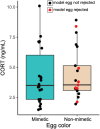Patterns of stress response to foreign eggs by a rejecter host of an obligate avian brood parasite
- PMID: 36699567
- PMCID: PMC9848814
- DOI: 10.1002/ece3.9691
Patterns of stress response to foreign eggs by a rejecter host of an obligate avian brood parasite
Abstract
One of the most effective defenses of avian hosts against obligate brood parasites is the ejection of parasitic eggs from the nests. Despite the clear fitness benefits of this behavior, individuals within so-called "egg-rejecter" host species still show substantial variation in their propensity to eliminate foreign eggs from the nest. We argue that this variation can be further understood by studying the physiological mechanisms of host responses to brood parasitic egg stimuli: independent lines of research increasingly support the hypothesis that stress-related physiological response to parasitic eggs may trigger egg rejection. The "stress-mediated egg rejection" hypothesis requires that hosts activate the stress-response when responding to parasitic egg stimuli. We tested this prediction by asking whether hosts showed differential stress response when exposed to host-like (mimetic) or parasite-like (non-mimetic) eggs. We experimentally parasitized incubating American robins Turdus migratorius, a robust egg-rejecter host to obligate brood parasitic brown-headed cowbirds Molothrus ater, with mimetic or non-mimetic model eggs. To assess the stress response, we measured the heart rate in incubating females immediately after experimental parasitism. We also measured plasma corticosterone and, in a subset of birds, used RNA-sequencing to analyze the expression of proopiomelanocortin (POMC), a precursor of adrenocorticotropic hormone, 2 h after experimental parasitism. We found that egg type had no effect on heart rate. Two hours following experimental parasitism, plasma corticosterone did not differ between the differently-colored model egg treatments or between rejecter and accepter females within the non-mimetic treatment. However, females exposed to non-mimetic eggs showed an upregulation of POMC gene expression (before FDR correction) in the pituitary compared with females treated with mimetic eggs. Our findings suggest that in an egg-rejecter host species, non-mimetic parasitic eggs may increase the activity of the stress-related hypothalamic-pituitary-adrenal axis compared with mimetic eggs, although the temporal dynamics of this response are not yet understood.
Keywords: HPA axis; coevolution; egg rejection; host–parasite interactions.
© 2023 The Authors. Ecology and Evolution published by John Wiley & Sons Ltd.
Conflict of interest statement
All authors have no conflicts of interest to declare.
Figures







Similar articles
-
Exposure to a mimetic or non-mimetic model avian brood parasite egg does not produce differential glucocorticoid responses in an egg-accepter host species.Gen Comp Endocrinol. 2021 Apr 1;304:113723. doi: 10.1016/j.ygcen.2021.113723. Epub 2021 Feb 2. Gen Comp Endocrinol. 2021. PMID: 33539900
-
Non-invasive elevation of circulating corticosterone increases the rejection of foreign eggs in female American robins (Turdus migratorius).Horm Behav. 2022 Nov;146:105278. doi: 10.1016/j.yhbeh.2022.105278. Epub 2022 Nov 14. Horm Behav. 2022. PMID: 36395578
-
Experimental shifts in intraclutch egg color variation do not affect egg rejection in a host of a non-egg-mimetic avian brood parasite.PLoS One. 2015 Apr 1;10(4):e0121213. doi: 10.1371/journal.pone.0121213. eCollection 2015. PLoS One. 2015. PMID: 25831051 Free PMC article.
-
A review of the cues used for rejecting foreign eggs from the nest by the Eurasian blackbird (Turdus merula).Ecol Evol. 2022 May 6;12(5):e8886. doi: 10.1002/ece3.8886. eCollection 2022 May. Ecol Evol. 2022. PMID: 35571754 Free PMC article. Review.
-
Beyond genes-for-behaviour: The potential for genomics to resolve long-standing questions in avian brood parasitism.Ecol Evol. 2024 Nov 17;14(11):e70335. doi: 10.1002/ece3.70335. eCollection 2024 Nov. Ecol Evol. 2024. PMID: 39575141 Free PMC article. Review.
References
-
- Abolins‐Abols, M. , & Hauber, M. E. (2020b). Proximate predictors of variation in egg rejection behavior by hosts of avian brood parasites. Journal of Comparative Psychology, 134, 412–422. - PubMed
Associated data
LinkOut - more resources
Full Text Sources
Miscellaneous

